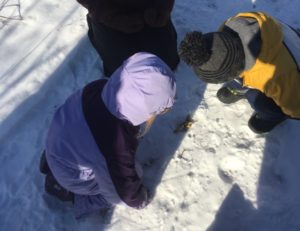Written by Jessica Johnsrud, Education Coordinator
At Woodland Dunes, we often talk about the importance of spending time outdoors. Taking time to notice nature is healthy for everyone and especially important for young children. Many parents and caregivers express a lack of confidence in knowing enough about the natural world or claim they aren’t “outdoorsy” enough to engage their child in nature. I understand this concern, but assure you that you do not need to be a nature expert to spend time outside with the children in your life. A recent Raising a Wild Child program, a program that meets monthly and is designed for children ages 2-5 years old and their caregivers, is a great example of this concept.
A group of nine youngsters and their caregivers explored a topic of great interest to preschoolers: scat. Scat is the science word for animal droppings. Anyone who has spent any length of time with young children knows this is a fascinating topic for this age group! We started by reading a children’s book about scat, then headed outside for a nature wander.
Before each nature wander here, we review the tools the kids always have with them to explore when curiosity strikes: their eyes, ears, nose and hands. Then the kids and their adults set off looking for animal scat. Recently, after a short time, I heard a small voice exclaim, “Scat! We found scat!” Everyone gathered together to investigate a large pile of dark, jellybean-shaped droppings. I asked a simple series of questions to get everyone thinking. I explained to the parents that they could use this kind of questioning anytime their child shows interest in nature (even if it’s something they are unfamiliar with). These questions should ask the kids to make observations about what they see, then use that information to create an idea or draw a conclusion.
I asked the group to describe the color, shape and if they thought a big or small animal left it. Could they see any clues in the scat about what the animal ate such as fur, seeds or grass? Finally, I asked what animal they thought left this pile. The kids had a couple of ideas including a rabbit or a deer. I encouraged them to look for tracks close to the scat. Sure enough, there were tracks next to the pile! Again, I asked some questions, “Did this animal have toes or hooves?” Could they see claw marks?” The kids noted the animal had hooves and declared it was a deer that left the scat. They were correct and very proud of figuring this out. Even if I hadn’t known the answer, that is okay. The ideas the kids came up with were great and they were using investigation skills. We could have looked in a field guide or online to solve the mystery later.
The morning concluded with a project inside the Nature Center. Each child was given a photo of scat and used play dough and “add-ins” to make a realistic replica. Red candies represented berries, broken pieces of pasta were bones, cotton balls were fur and more. The “wild” children enjoyed this project and there were a few giggles about making “poop.”
I hope this example demonstrates how easy it can be to spend time outside with children. As the adult, you don’t need to know all the answers, you just need to be there as a guide.
